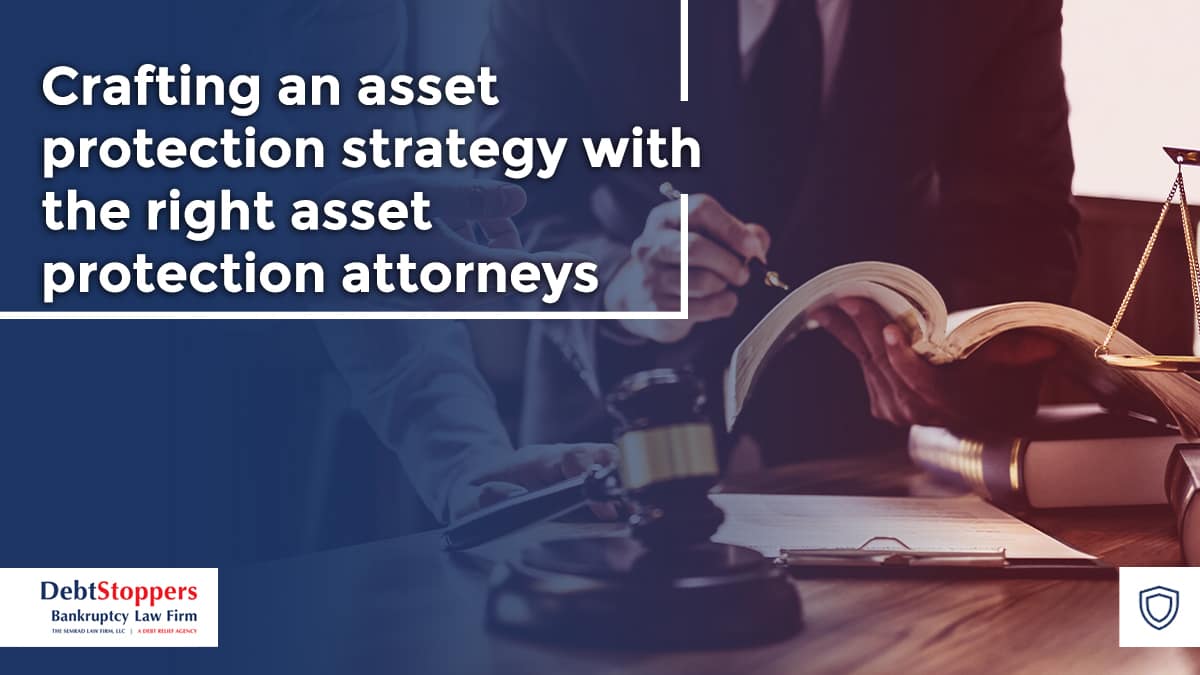There are several strategies you can use to protect your assets. An experienced attorney can help you craft and implement a strategy that fits your unique needs and protects your assets.
Asset protection strategies are designed to safeguard your assets from potential risks, liabilities, or creditor claims. The primary goal of asset protection is to shield assets from being seized, garnished, or depleted in the event of lawsuits, judgments, bankruptcy, divorce, or other adverse circumstances.

What types of asset protection strategies are there?
Several strategies can be used to protect your assets including limited liability entities, trusts, transfers, and insurance.
Corporations, LPs or LLCs
Limited liability entities such as corporations, limited partnerships (LPs), and limited liability companies (LLCs) are commonly used business entities that offer asset protection benefits to their owners.
One of the primary benefits of corporations, LPs, and LLCs is that they provide limited liability protection to their owners. Meaning the owner's personal assets are generally shielded from the liabilities and debts of the business. If the business is sued or goes bankrupt, creditors typically cannot go after the personal assets of the owner to satisfy business debts.
By holding assets within a corporate or limited liability structure, owners can effectively partition their assets, which means that if one business venture or asset faces legal or financial trouble, it does not necessarily affect the other assets owned by the same entity or its owners.
Utilizing corporations, LPs, or LLCs can be an effective strategy for asset protection but business owners should consult with legal and financial professionals to determine the most appropriate structure for their specific needs and circumstances.
Asset protection trust
Trusts can help protect assets from various risks and potential threats including creditors, lawsuits, bankruptcy, and estate taxes. When assets are transferred into a trust, they are no longer owned by the individual (the settlor) but are instead owned by the trust itself. This legal separation of ownership creates a barrier between the assets and the settlor's personal liabilities, such as debts, lawsuits, or bankruptcy proceedings.
Trusts can hold a wide range of assets, including cash, real estate, securities, business interests, and more. Diversifying the trust's assets across different asset classes and investment vehicles can help mitigate risk and protect against fluctuations in the value of any single asset.
Trusts allow the settlor to designate beneficiaries who will ultimately receive the trust assets according to the terms of the trust document. Trusts are managed by trustees, who are often granted broad discretion and authority to manage the assets including making investment decisions, distributing income or principal to beneficiaries, and protecting the assets from potential threats.
Many trusts, particularly irrevocable trusts, are designed to be permanent arrangements that cannot be easily altered or revoked by the settlor. Once assets are transferred into an irrevocable trust, they are no longer considered part of the settlor's estate and are generally protected from estate taxes and creditors.
Many trusts include spendthrift provisions, which restrict beneficiaries' access to trust assets and prevent creditors from reaching those assets to satisfy the beneficiaries' debts or obligations. By limiting the beneficiaries' control over the assets, spendthrift provisions help safeguard the trust assets from external claims.
Trusts also offer a level of privacy and confidentiality that may not be available with other estate planning tools. Unlike wills, which become public record upon probate, trusts generally remain private documents, allowing the settlor to maintain confidentiality regarding their assets and beneficiaries.
Trusts serve as powerful tools for asset protection by legally separating assets from personal liabilities, establishing clear beneficiary designations, and providing mechanisms for asset management and preservation.
Transfer asset rights
Transferring asset rights can protect assets by legally transferring ownership or control of assets to another entity or individual. This strategy is often employed to shield assets from potential threats such as creditors, lawsuits, or other adverse circumstances.
One approach to protect assets is to transfer ownership of the assets to a trusted family member, friend, or entity. This transfer can be accomplished through various legal mechanisms, including outright gifts, sales, or transfers to trusts or other entities. Alternatively, you can establish a trust that allows you to transfer ownership of assets to a trustee, who manages the assets for the benefit of designated beneficiaries. Depending on the type of trust and its terms, assets held in trust may be protected from creditors, lawsuits, or other claims against the settlor.
In some jurisdictions, homeowners can protect a certain amount of equity in their primary residence from creditors through homestead exemptions. By transferring assets into a homestead-exempt property, you can shield those assets from certain types of creditor claims.
Assets held within qualified retirement accounts such as 401(k)s, IRAs, and pension plans are often protected from creditors under federal and state law. Transferring assets into these accounts can provide a level of asset protection while also offering tax advantages for retirement savings.
Asset transfers must be conducted carefully and with consideration for potential legal and tax implications. Improperly executed transfers or transfers made with the intent to defraud creditors may be subject to legal challenges and could be reversed by courts.
It's essential to consult with qualified legal professionals when considering asset transfers for asset protection purposes. An experienced attorney can help you understand the available options, navigate the legal requirements, and develop a comprehensive asset protection strategy tailored to your specific needs and circumstances. Additionally, asset protection strategies should be implemented proactively and in compliance with applicable laws to ensure their effectiveness and legitimacy.
Liability insurance
Liability insurance protects assets by providing financial coverage for legal liabilities and expenses arising from claims or lawsuits against the insured party. Liability insurance policies typically cover legal expenses associated with defending against lawsuits, including attorney fees, court costs, and settlements or judgments. Without insurance, these expenses could deplete personal or business assets significantly.
Liability insurance protects assets by indemnifying the insured party against claims of negligence, personal injury, property damage, or other covered liabilities. If a covered incident occurs, the insurance company pays damages, up to the policy limits, rather than the insured paying out of pocket.
By covering liabilities and legal expenses, liability insurance helps preserve assets from being seized or depleted to satisfy legal judgments or settlements. Without insurance, you may be forced to liquidate assets or declare bankruptcy to pay your legal obligations.
Overall, liability insurance can help protect assets against the financial risks and liabilities associated with lawsuits, claims, or other legal disputes. It provides financial resources and legal support to defend against claims and helps preserve personal and business assets from being jeopardized in the event of unforeseen legal challenges.

How to choose the right asset protection strategy for your situation?
Choosing the right asset protection strategy requires careful consideration of your individual circumstances, financial goals, and risk tolerance.
Assess your assets and risks
You should start by conducting a thorough assessment of your assets, including real estate, investments, savings, business interests, and personal property. Evaluate your potential liabilities, such as outstanding debts, legal obligations, or risks specific to your profession or industry.
Consider laws and regulations
It’s also important to familiarize yourself with legal protections available in your jurisdiction, including homestead exemptions, retirement account protections, and other state-specific laws governing asset protection. It’s essential to fully understand the limitations and requirements associated with each form of protection.
Seek advice from asset protection attorneys
Given the complexity of the legal and regulatory requirements, it’s wise to consult with an experienced attorney specializing in estate planning, asset protection, or bankruptcy who can provide valuable insight and assistance navigating complex legal considerations.
An experienced professional can help you understand your options and choose the strategy that best fits your needs. A qualified legal professional with expertise in asset protection can help you adequately assess your assets and liabilities, identify potential risks, consider risk tolerance, understand legal protections, evaluate various strategies, customize your plan, and implement safeguards.
How to choose the best asset protection lawyer?
Choosing the best asset protection lawyer is crucial for implementing an effective asset protection plan tailored to your specific needs and circumstances. To select the right asset protection lawyer you first need to identify your needs.
Then ask for recommendations from trusted sources, such as family members, friends, or colleagues who have experience working with asset protection lawyers. Additionally, seek referrals from other professionals and research the qualifications and credentials of potential asset protection attorneys who specialize in asset protection, estate planning, or bankruptcy.
It’s important to assess the lawyer's expertise and track record in asset protection law. Inquire about their experience handling cases similar to yours, their success rate in implementing asset protection strategies, and any notable accomplishments or recognitions in the field.
Next, schedule initial consultations with several potential asset protection lawyers to discuss your needs and evaluate their suitability. Use this opportunity to ask questions, assess their communication style, and determine if you feel comfortable working with them. During consultations, discuss the lawyer's approach to asset protection and their proposed strategies for achieving your goals. Look for a lawyer who takes the time to understand your concerns, provides personalized advice, and offers creative solutions tailored to your situation.
You should also inquire about the lawyer's fee structure, billing practices, and any additional costs associated with their services. Choose a lawyer whose fees are transparent and reasonable. Make sure to carefully review the engagement agreement or retainer agreement to ensure that the terms and conditions are clear, including the scope of services, responsibilities of both parties, and any fees.
Ultimately, trust your instincts and choose a lawyer you feel confident in and comfortable working with. Selecting the right asset protection lawyer is a significant decision, so take the time to make an informed choice.





